Why Are We Losing So Many Older Women to Drug Overdose Deaths?
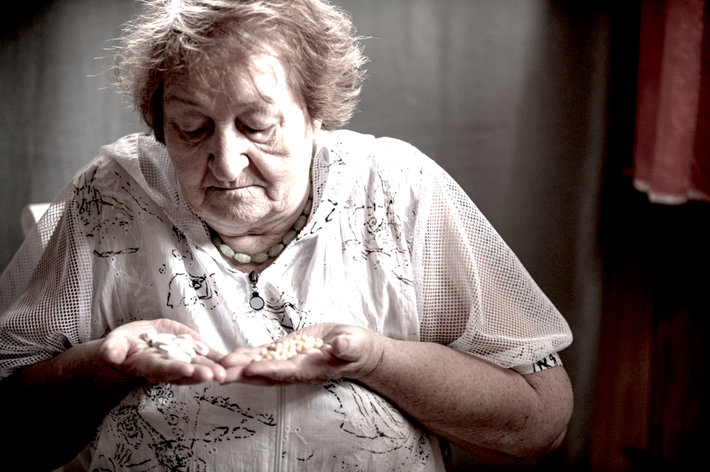
As they age, many women begin thinking ahead to their older years when they might be able to slow down and enjoy life more.
Sure, there might be some physical limitations but there’s going to be more time with the grandkids. There might be time to travel to places they’ve always wanted to visit or take up crafts they were too busy to enjoy.
Just about the last thing on anyone’s mind is the possibility that some of these older female Americans might be lost to drug overdoses.
Can that possibly be true? According to information released by the Centers for Disease Control and Prevention (CDC), yes. Drug overdoses among mature women have been increasing rapidly.
This chart compares the rate of drug overdose deaths among women aged 30 to 64. The light blue bars show the overdose rates per 100,000 women in that age group in 1999. The dark blue bars show the rate in 2017.
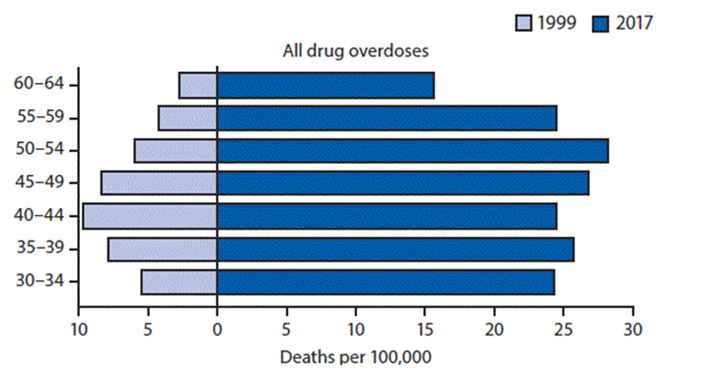
You’ll see that the very highest rate of death is among women 50 to 54. And look how low the rate was in 1999 for deaths among women 60 to 64 compared to the number in 2017.
It’s appalling that these numbers have increased more than three-fold in less than two decades. In 1997, we lost fewer than 7 women per 100,000. By 2017, that number had rocketed to more than 24. The total number of overdoses rose from 4,313 to 18,110.
Which Drugs Are Doing the Most Damage?
Which drugs are stealing the most mothers, aunts, older sisters or grandmothers? A look at the increases caused by specific drugs is just as heartbreaking as looking at the increase in overall drug overdoses.
Prescription Opioid Overdoses
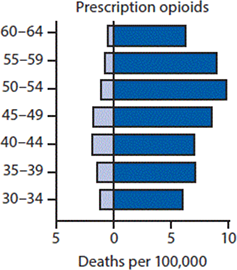
In this chart, you can see how few women lost their lives to painkillers like OxyContin, Vicodin, Lortab, Percocet, Percodan, Dilaudid and other pain relievers in 1999. Out of 100,000 women, just a couple in each age group were lost that year.
This rate went up 485% across all age groups by 2017.
In 1999, aggressive marketing of opioid painkillers was still in its infancy. The increased prescribing that was generated from this aggressive marketing resulted in increased overdoses in both genders and all age groups.

Heroin Overdoses
This chart compares the heroin overdoses from 1999 to those of 2017. Over this period of time, the rate of overdose deaths increased an appalling 915%. In this particular situation, the greatest loss of life is among younger women. But older women are now also being lost, whereas there were no losses in 1999.
Fentanyl Overdoses
This is where the increases in overdoses simply get astronomical. This chart shows an overall increase of 1,643% in fatal overdoses of synthetic opioids. In the vast majority of cases, this means fentanyl. Here too, the greatest increases were among younger women. But like with heroin, older women who were not being impacted at all by this drug in 1999 are now being lost.
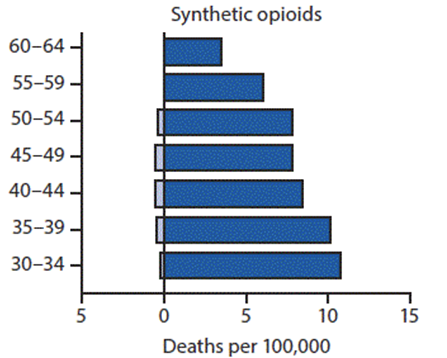
In 1999, those few fentanyl deaths were the result of prescribed fentanyl or pharmaceutical fentanyl that was diverted from medical supplies.
Fentanyl is an extremely powerful painkiller that is normally only used in cases of severe pain that nothing else will ease—such as end-of-life pain.
Supplies of this drug are strictly controlled so it is not easy to divert medical supplies to the illicit market. So very few people died of fentanyl overdoses.
For a short period around 2006, illicitly-manufactured fentanyl flooded the market when it began being manufactured at a single clandestine lab in Mexico.
More than a thousand people lost their lives as a result of this drug being added to illicit drug supplies—mostly heroin.
The lab was found and closed and fentanyl overdose deaths dropped. Then in 2014, fentanyl deaths began to surge up again. This time, it was clandestine labs overseas doing the manufacturing. Efforts have been made to curtail this manufacturing but it is difficult for American law enforcement agencies to close down labs in Asia.
American drug dealers have discovered how profitable trafficking in fentanyl is. Since it is far more powerful than heroin, it takes only the tiniest amount of fentanyl powder to get a person high. A tiny bit more results in a fatal overdose.
The quantity of fentanyl coming into America keeps increasing and overdose deaths follow. That’s how we get a 1,643% increase in fentanyl deaths across all age groups.
A Look at Possible Causes
Why are we losing so many more women in 2017 than in 1999? Of course, it’s a complicated problem with many factors involved. Such as:
- Addiction and overdose prevention efforts have focused on younger Americans.
- Older adults, in general, tend to be on multiple prescription medications and among older women especially, it’s common for one of these to be an opioid painkiller.
- Women are given painkiller prescriptions more frequently than men. According to one study that examined statistics between 1993 and 2014, 54% of women getting outpatient treatment were prescribed opioid painkillers, compared to 46% of men.
- Too many doctors of all types are not yet well-trained to identify a patient that is dependent on medication. If they were, they might see the signs in patients of all ages. It’s very likely that doctors are currently more alert to the possibility of drug-seeking and addiction among younger patients.
- As women get older, they may be living alone after the death of a spouse and when children have moved out of the home. There might not be anyone to monitor pill counts or to notice that they are taking pills more frequently than recommended. A woman may take too many pills or take them too frequently, increasing her chance of drug dependence.
- An isolated woman may find that she feels more comfortable if she continues taking painkillers even after their pain has resolved because of the relaxing, mellowing effect of opioids. Her addiction could be unintentional but no less devastating.
- A check for pain level; asking the patient to rate their level of pain from 1 (the least) to 10 (the worst almost calling for hospitalization) as part of the vitals at the start of any exam. Too often this question is asked without clarifying what is really being asked; leading to a wrong assessment of the patient's needs and possibly prescribing unnecessary painkillers.
Dependence on Painkillers
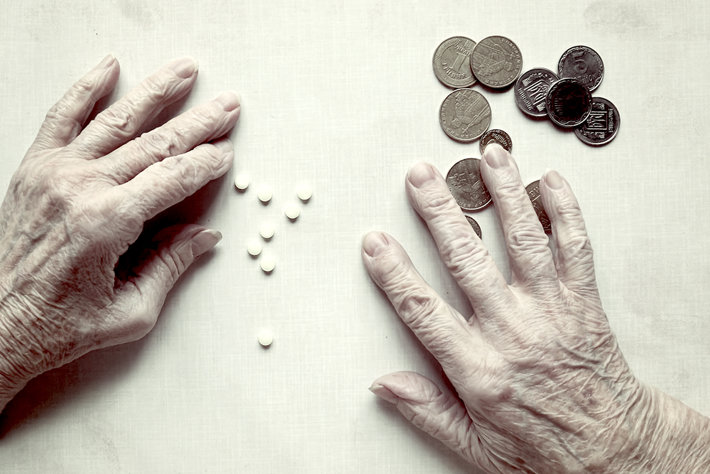
Great care must be taken when potentially addictive medications are prescribed to prevent dependence. The Centers for Disease Control and Prevention has recently issued guidelines for both patients and prescribers to try to limit prescribing and reduce the chance a patient will become dependent on medication needed after an injury or surgery.
If a doctor misses the signs that a patient has become dependent and continues to refill a prescription for a patient who says she still hurts, the patient could begin to rely on this drug to help her get through life every day. In other words, she could become psychologically dependent on having this drug in her life.
Unfortunately, not all doctors know what to do even when they do see these signs. Doctors may fear prosecution if they prescribe too many painkillers. If they refuse to prescribe any more painkillers, a patient may feel they have to turn to the illicit market to obtain the kind of drug they rely on.
Therefore, they begin to buy heroin to replace the painkillers they could no longer get because doctors cut them off or they ran out of money to pay for prescriptions. The chart of heroin overdoses above shows you the result. And because fentanyl is mixed into so many illicit drug supplies, we also have this increasing number of losses to fentanyl.
How Do We Resolve This Situation?
For most of us, it’s later in life when pain from arthritis begins to show up. In general, there are also more joint replacement surgeries and back surgeries, and more cases of cancer. It’s vital to pay close attention to prescriptions for pain medications for oneself or an older female one cares about.
Doctors should prescribe the fewest number of pills for the short-term pain. If there is long-term pain, the true cause of the pain should be found and remedied whenever possible so that opioids aren’t needed for months or years. With opioids, the shorter the time period they are consumed, the better.
A younger person caring for an older person on medication should count their pills and ensure they are not being used up too quickly. If they are, perhaps someone else should hand out the pills, and the person’s doctor should get involved.
When doctors, patients, and their families all ensure prescriptions of opioids are used with care, we can curtail these increases and begin to save more lives.


 ®
®